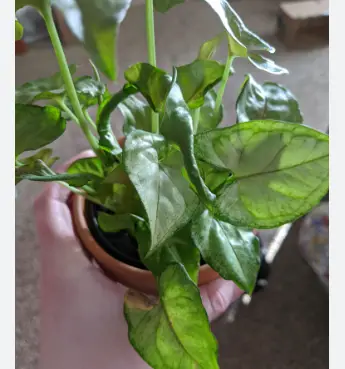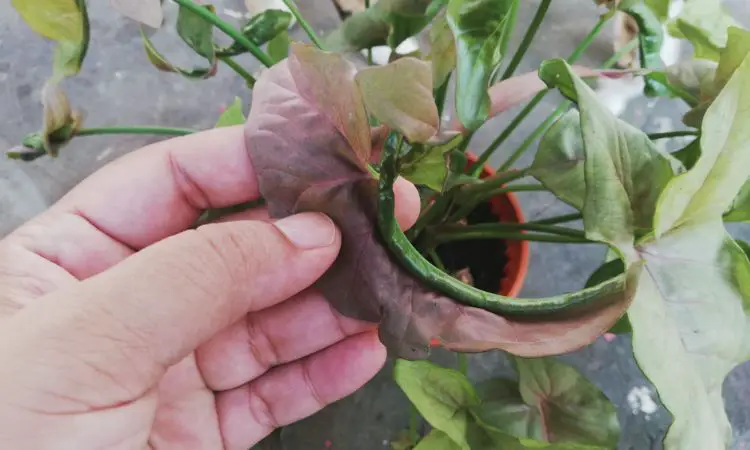Most Syngonium plants, commonly called Arrowhead Plants, owners get confused when they see leaves not unfurling on their plants.
So, why are your Syngonium leaves not unfurling?
The reasons are low humidity, Improper watering, etc. Also, root problems, lack of nutrients, lack of light, and high temperature can evoke this problem in Syngonium plants. Unfurling can be improved by appropriate watering practices, providing balanced fertilization, and increasing humidity levels.
Here, we’ve provided detailed information about how can you fix your plant’s leaves not an unfurling issue.
Reasons And Fixes for Unfurled Syngonium Leaves

Here’s a quick table to understand the main reasons why leaves not unfurling and how you can fix it.
| Reasons | Fixes |
| Improper watering | Adjust the watering schedule and make sure the soil is not too dry or too wet. |
| Lack of nutrients | Fertilize the plant with a balanced fertilizer according to the instructions. |
| Low humidity | Increase the humidity around the plant. |
| Lack of light | Move the plant to a spot with sufficient sunlight. |
| Extreme temperature | Move it to an enclosed spot during winter and protect it from direct sunlight during summer. |
Now, let’s get down to the detailed reasons and solutions that we’ve found for Syngonium leaves.
Reason 1: Improper Watering
Both overwatering and underwatering can have negative effects on the ability to unfurl leaves in your arrowhead plants.
- Overwatering: When a Syngonium plant is overwatered, the soil becomes saturated, leading to waterlogged conditions. Due to a lack of oxygen, excess moisture can cause root rot. Some other plants like Plumeria Stem also get wrinkled because of over-watering.
- Underwatering: If a Syngonium plant is consistently underwatered, the soil becomes too dry, depriving the roots of adequate moisture. As a result, the leaves may wilt, curl, or fail to unfurl properly.
Fix:
Providing sufficient water to a Syngonium plant while avoiding overwatering is crucial for its health. So you should follow the below instruction.
- Watering frequency: As a general guideline, water your Syngonium when the top inch of soil feels dry. Avoid watering on a strict schedule. Instead, assess the moisture content of the soil to determine when watering is needed.
- Moist, not wet soil: Syngonium plants thrive when the soil is consistently moist but not excessively wet. After watering, allow the top inch or so of the soil to dry out slightly before watering again. It is better to not use rocky soil to plant your Syngonium. But some vegetables grow well in the rocky soil.
- Drainage: Ensure that the pot has drainage holes to allow excess water to escape. Otherwise, water may accumulate at the bottom and cause excessive wetness leading to root rot. Thus preventing proper leaf unfurling.
Reason 2: Lack of Nutrients
When Syngonium plants lack some of its essential 16 nutrients, it results in impaired leaf unfurling.
These 16 essential nutrients are divided into Macro and Micronutrients. Nitrogen, Phosphorus, Potassium, etc are macronutrients that contribute to proper growth.
On the other hand, Micronutrients are Iron, Magnesium, Calcium, etc. which contribute to the physiological process of Syngonium plants.
Fix:
It is crucial to conduct a comprehensive test if you suspect a nutrient deficiency in your Syngonium plant.
- First, Identify the specific nutrient that is lacking in the plant.
- Provide the plant with the necessary nutrient it needs, such as magnesium if it is deficient in that nutrient.
- Ensure the plant has access to the minimum essential nutrients required for thriving.
- If any nutrients are in limited supply, replenish the soil with the deficient nutrients.
- Apply fertilizers to support the healthy growth of your Syngonium plant.
Reason 3: Low Humidity
Syngonium can suffer adverse effects when its leaves are not exposed to high humidity, usually around 40% or higher.
A low-humidity environment accelerates transpiration, resulting in brown spots on the arrowhead plant’s leaves. As a protective measure to conserve moisture, Syngonium leaves curl or furl under low humidity conditions.

Fix:
To reduce transpiration in your Syngonium plant, increase the humidity level in your house. Here’s how-
- Pebble Tray Method: Fill a shallow dish or tray with water and place a layer of pebbles or rocks in it. Place the Syngonium pot on top of the pebbles, ensuring that the water level is below the bottom. As the water in the tray evaporates, it increases the humidity around the plant.
- Humidifier: Using a humidifier is a convenient and efficient way to increase humidity levels in the air, especially during winter. Set up a humidifier near your Syngonium plant to release moisture into the environment.
- Water-filled Containers: Place bowls, cups, or any other suitable containers filled with water near your Syngonium plant. As the water slowly evaporates, it increases the humidity in the immediate vicinity.
- Relocating to a Humid Room: You can temporarily move your Syngonium plant to a room with higher humidity.
By implementing these techniques, you can raise the humidity levels around your Syngonium plant.
Reason 4: Lack of Light
Insufficient light can cause two scenarios for the Syngonium plants. These are-
- Insufficient food: Without an adequate light source, the plant is unable to produce its own food, resulting in weakened growth. Insufficient light exposure impacts not only the plant’s ability to generate energy but also its leaves’ optimal performance.
- Yellow leaves: Over time, the leaves may lose their dark pigmentation and begin to curl. Lack of light may eventually cause the affected leaves to turn yellow and drop off.
Fix:
It is important to provide your Syngonium plant with sufficient light. A bright window or supplemental artificial lighting can ensure that the plant receives the light it needs.
Maintaining vibrant, unfurled leaves and promoting plant vitality can be achieved by monitoring the plant’s light requirements regularly. Plants like cypress vine and cardinal climber also grow well in sunlight.
Reason 5: ExtremeTemperature
Extreme temperature fluctuations can cause the leaves of your arrowhead plant to curl. The effects are adverse in different seasons, especially in winter and summer.
- During the Winter Season: very cold temperatures can cause leaf curling in Syngonium plants. Research suggests that Syngonium leaves may start to curl when temperatures fall below 70 degrees Fahrenheit (21 degrees Celsius).
- During Hot Summer Months: Your Syngonium leaves may curl due to increased transpiration (water loss) in the hot summertime.
Fix:
To protect your Syngonium leaves from curling due to temperature stress, it is recommended to take the following measures:
- Cold temperatures: During winter, when temperatures are extremely cold, it’s best to store your plant inside an enclosed room. This will help cushion the plant from the adverse effects of cold temperatures.
- Hot temperatures: During the summer months, when temperatures are excessively hot, it’s important to protect your Syngonium from direct sunlight. Excessive heat and intense sunlight can lead to leaf curling.
The recommended temperature range for Syngonium plants is 45°F (7°C) to 85°F (30°C). Keep the plant within this temperature range to prevent leaf curling.
Frequently Asked Questions (FAQs):
How Long Does It Take for A New Leaf to Unfurl?
It typically takes around 2 to 3 weeks for Syngonium leaves to fully open. But the soil needs to be properly moistened and the plant’s roots are healthy and absorbing moisture.
Should You Mist An Unfurling Leaf?
Yes, you should. When the leaves of your plants are unfurling, it is beneficial to have a mister on hand. Misting your plants during this stage provides a humidity boost that can be advantageous for their growth.
Which Fertilizer Is Best for Leaf Growth?
The best fertilizer for promoting leaf growth is one that contains nitrogen. Nitrogen is a vital nutrient for the production of leaves, stems, and overall vegetation growth. For lawns and leafy vegetables, a high-nitrogen fertilizer is recommended to support robust leaf growth.
The End
Now you know why your Syngonium leaves not unfurling.
Syngonium plants require bright, indirect light and humidity to thrive and unfurl leaves properly. So, mind the placement and humid location for your Syngonium plant.
- Why Are There Still No Tomatoes in My Tomato Plants? Let’s Fix the Issue! - July 13, 2023
- Water Propagation White Stuff on Roots: Everything You Should Know! - July 11, 2023
- String of Dolphins Drying Up: Solved! - July 11, 2023
